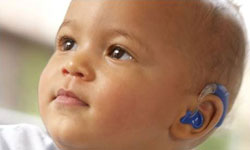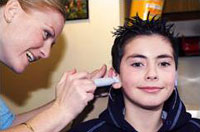
The hearing aid sits behind your child's ear and is held in place by an earmould in the ear. A microphone in the hearing aid picks up sounds around the child and makes them loud enough for your child to hear comfortably.
The sound passes from the hearing aid through the plastic tube in the earmould into your child's ear. It is important that the earmould is a good fit and is properly inserted, and that the tube is kept clean and flexible.
To ensure a well fitting earmould, regular impressions (where we take the shape of your child's ear in putty) are required especially when your child is very young and growing quickly.
Here are some explanations for some of the technical phrases that are used to describe the programming/settings of hearing aids:
Amplification
Amplification describes how sounds are made louder by the hearing aid. This can be done in different ways depending on the hearing aid and the type of hearing loss. The amplification will have been set appropriately for your child. The most common form of amplification that we use for children is:
Wide dynamic range compression (WDRC)
Sounds are amplified by different amounts depending on how loud they are to start off with, which is similar to how the cochlea (hearing organ) works. Quiet sounds are amplified more, while loud sounds are not amplified as much.
Prescription formula
This is a method for calculating how much amplification should be given and is based on the latest hearing test results for your child. The most commonly used prescription formula for children is DSL (Desired Sensation Level)

Real Ear Measurements (REMs)
REMs are measurements of sound in the ear canal using a soft, thin tube that sits just inside the ear canal. They are needed because everyone's ears are a different size and shape. They allow us to set up the hearing aids so that sounds are amplified in the correct way for your child's hearing loss. A simple technique which is commonly used for children is an RECD.
Real Ear to Coupler Difference (RECD)
This is a measurement of sound in your child's ear with the ear mould in place. This measurement is quicker than adult REMs and can then be used to set the hearing aids up on the computer.
Coupler Match
This is a measurement of sound in an ear simulator. It is used when we are unable to make the measurements on your child's ear and is used to set the hearing aids up on the computer
Radio Aid/FM System
Radio aids are generally used in school to help your child hear the teacher above the noise in the classroom.


